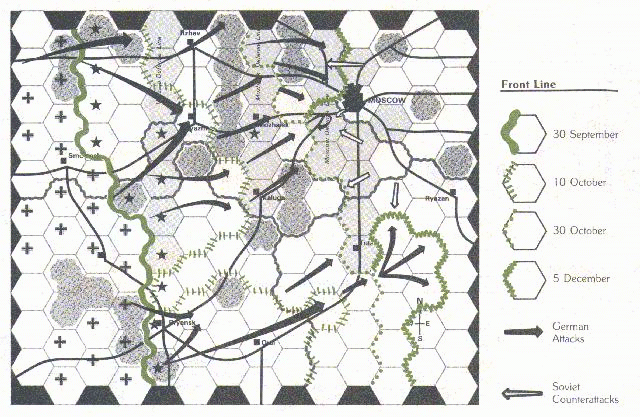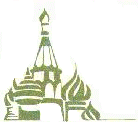


On 22 June 1941 Germany invaded the Soviet Union. Confident that the Blitzkrieg was invincible, the German high command expected to overrun most of the European portion of the U.S.S.R. in a matter of weeks, crushing the Soviets' ability to resist and securing German mastery of Europe.
Initially successful on all fronts, the German invasion reached deep into the Soviet Union throughout the summer of 1941. The Soviets, however, used their large population and abundant resources to constantly field new forces, replacing the millions of men lost. Although often poorly equipped and inexpertly led, the Soviet soldiers learned to fiercely resist the invaders as they defended Mother Russia. By autumn, the Germans were approaching many key cities in the Soviet Union: Len ingrad, Moscow, Kharkov, and Rostov, but German reserves were dwindling and the bad weather of autumn was rapidly approaching.
Operation Typhoon: In September the German High Command decided to launch a final, decisive offensive for the year to capture Moscow and break the Red Army--Operation Typhoon. Gathering forces from across the entire front, the Germans launched their offensive in early October. The Soviets did not expect a German offensive so late in the season and were taken by surprise. The Soviet front line was quickly shattered and surrounded, with over 600,000 men taken prisoner in pockets at Vyazma and Bryansk.
While the German infantry cleared the pockets, the panzers raced towards Moscow. However, the Germans were slowed both by the desperate resistance of the remaining Soviet forces in the defense lines built before Moscow and by the weather. The autumn rains had started by mid-October, and they quickly turned the dirt roads to mud, greatly restricting Ger man mobility. Even so, by the end of October the Germans had captured Mozhaisk, the last major town on the direct road to Moscow, and were approaching Tula on the southern route to the Soviet capital. At their closest, the Germans were now only 40 miles from Moscow.
In November the rains slackened, and the Germans would have a short period of clear weather before the Russian winter began. However, the German forces had no reserves left, and their strength was dropping, while fresh, new Soviet forces were arriving at the front. The Germans resumed the offensive in mid-November. In front of Moscow, the Germans were stalled as the Soviets launched repeated counterattacks. In the south the Germans, unable to take Tula, bypassed the city. In the north the Germans slowly inched forward to the gates of Moscow. By 5 December, the Germans were halted along the entire front. Exhausted and demoralized, the German forces had failed to take their objective. The next day, amidst the snows and intense cold of the onset of winter, the reinforced Soviets launched their winter counteroffensive.


Please report any problems with this page (bfm/typhoon.html).